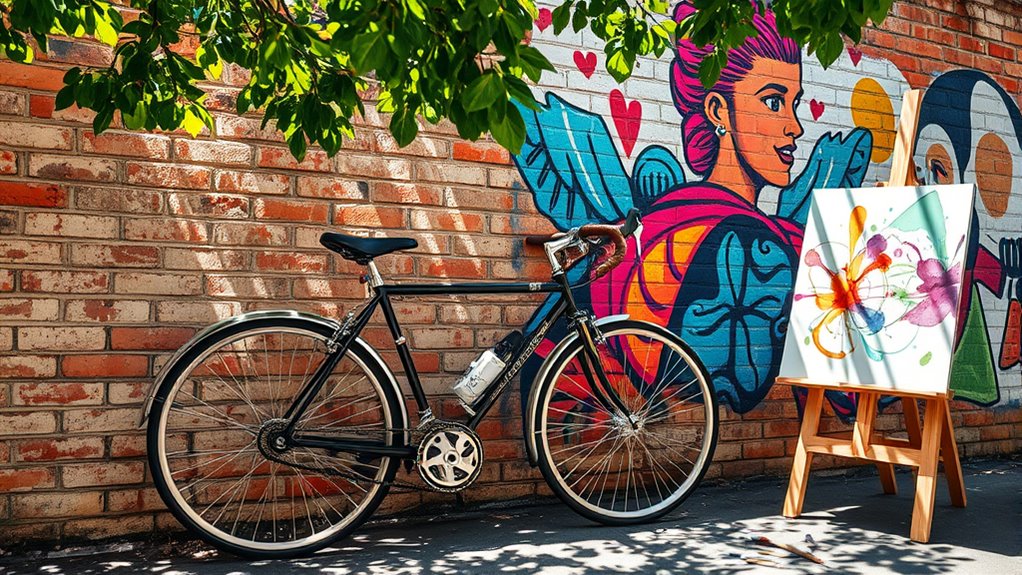Bikes inspire creativity by serving as powerful symbols of freedom, movement, and resilience in diverse art forms. You’ll see them featured in street murals, sculptures crafted from bike parts, and vibrant photography capturing motion and energy. Cycling also influences literature and poetry, symbolizing adventure and escape. Through these artistic expressions, cycling shapes public perception and culture. Keep exploring how art and bikes connect to discover even more inspiring ways they drive creativity and community.
Key Takeaways
- Bikes serve as artistic symbols representing freedom, movement, and life’s journey in paintings, sculptures, and murals.
- Recycled bike parts are transformed into kinetic sculptures and installations, promoting sustainability and mechanical beauty.
- Cycling culture inspires street art and murals that depict dynamic scenes, iconic designs, and urban mobility themes.
- Photographers and artists capture motion and energy through visual effects like blur and trails, emphasizing cycling’s aesthetics.
- Bikes influence storytelling in literature and art, symbolizing adventure, mastery, and the connection between humans and nature.
Bikes as Artistic Symbols and Motifs
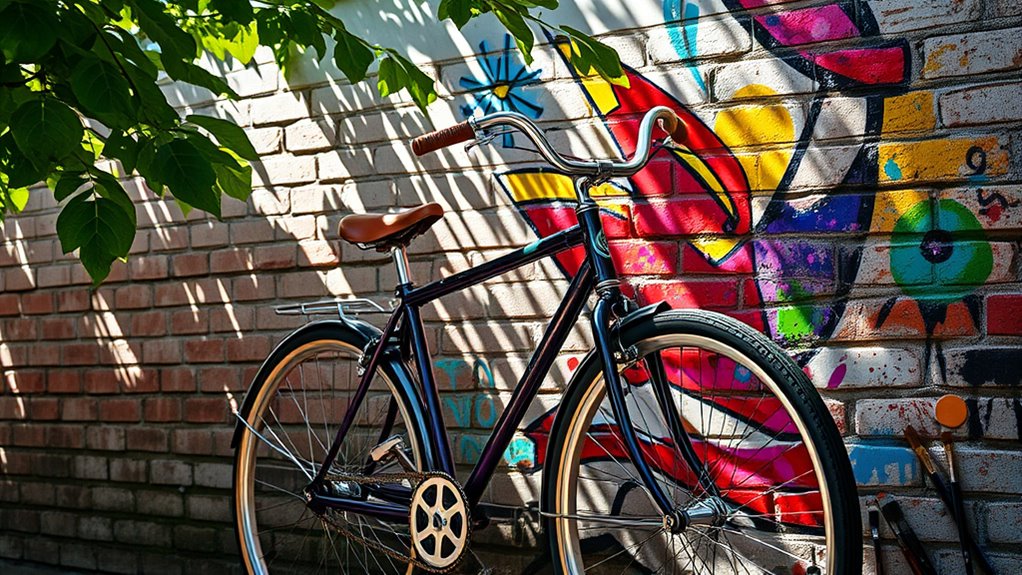
Bikes have long served as powerful symbols in art, representing freedom, movement, and the journey of life. Their bike symbolism often appears in various artistic motifs, conveying ideas of progress, independence, and adventure. Artists use bicycles to evoke a sense of liberation, highlighting the joy of exploration and the thrill of the open road. You’ll see bike imagery in paintings, sculptures, and illustrations that emphasize motion and progression. These artistic motifs tap into universal themes, making bikes a versatile symbol across cultures and eras. Whether depicted as vintage silhouettes or dynamic line drawings, bicycles inspire viewers to reflect on personal growth and the endless possibilities that come with every new ride. Incorporating rustic elements and handmade details can further enhance the nostalgic and artistic appeal of bicycle-inspired decor. Additionally, the symbolism of bicycles underscores themes of resilience and renewal, resonating deeply within contemporary art and design. Recognizing the predictive modeling in art history can also help interpret how recurring motifs influence modern perceptions of mobility and independence.
Street Art and Murals Celebrating Cycling Culture
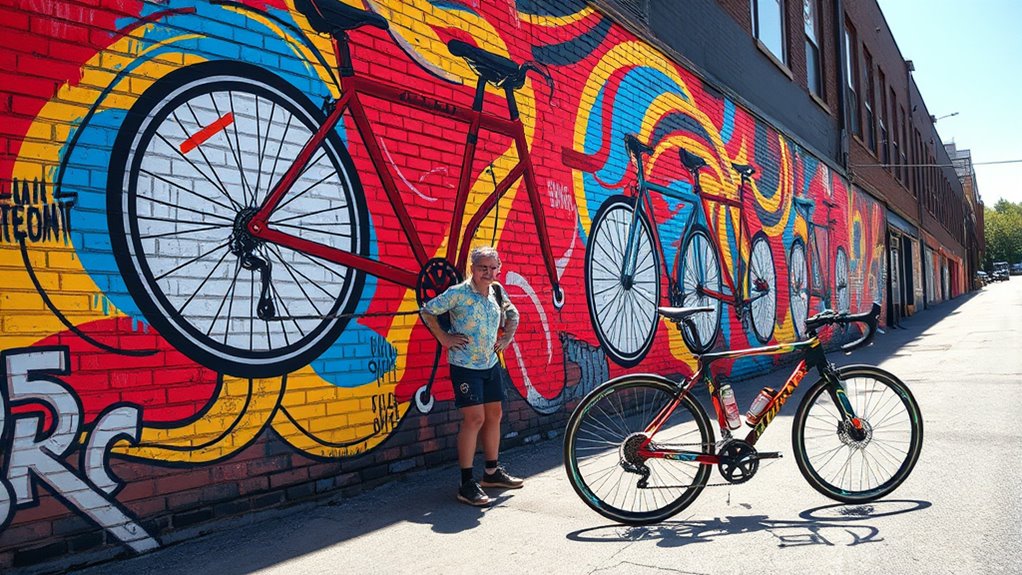
Street art and murals have become vibrant expressions of cycling culture, transforming urban landscapes into open-air galleries that celebrate the joys and values of riding. You’ll notice these urban murals and graffiti art pieces often depict dynamic cyclists, iconic bike designs, and scenes of community rides, inspiring viewers and fostering a sense of belonging. These artworks serve as visual stories that highlight cycling’s role in sustainability, freedom, and urban mobility. Additionally, they often incorporate geometric shapes, reflecting the fundamental principles of geometry that influence design and composition in art. The use of such structural elements underscores how design principles from Gold IRA investments and asset diversification can inspire creative expression. This intersection between art and urban planning demonstrates how visual culture can influence public perception and support for cycling initiatives. Moreover, these murals often promote environmental awareness, emphasizing the importance of eco-friendly transportation options. Incorporating elements of aesthetic harmony can further enhance the visual impact and message of these artworks, creating a more compelling narrative. Below is a table illustrating the deeper meanings behind these pieces:
| Urban Murals | Graffiti Art |
|---|---|
| Community identity | Personal expression |
| Environmental activism | Artistic rebellion |
| Urban transformation | Youth empowerment |
Sculptures and Installations Made From Bike Parts
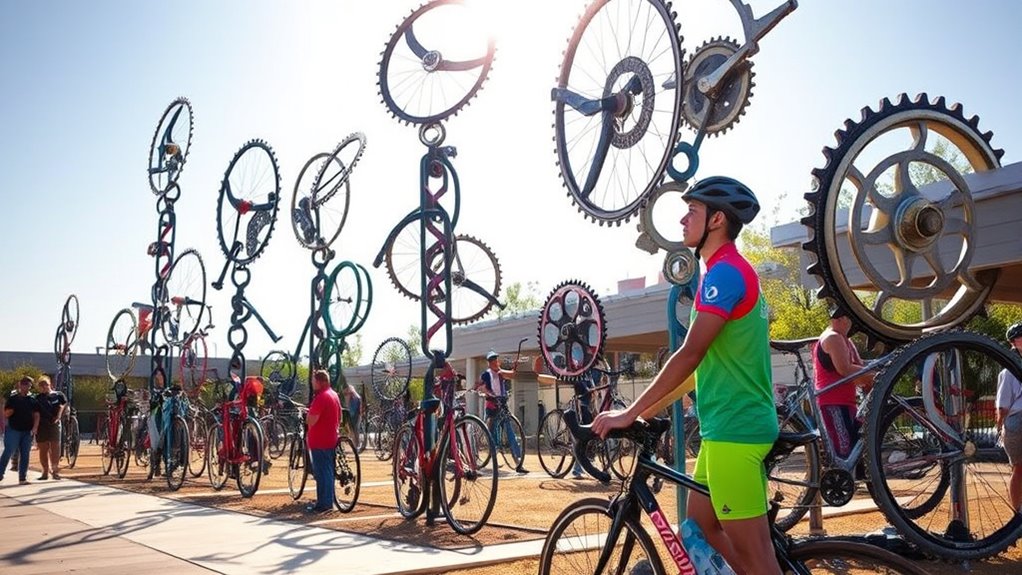
When artists repurpose bike parts into sculptures and installations, they transform discarded materials into compelling works of art that celebrate cycling’s creativity and sustainability. A growing trend is incorporating family influences that inspire personal narratives within these creations. Using repurposed bike parts, they craft intricate sculptures and dynamic kinetic sculptures that capture motion and energy. These pieces often highlight the mechanical beauty of bikes, turning rusty chains, gears, and frames into striking visual statements. By reimagining these components, artists challenge perceptions of waste and showcase cycling’s artistic potential. Incorporating sustainable materials allows artists to emphasize environmental consciousness while creating visually stunning pieces. The use of upcycled elements not only enhances the aesthetic appeal but also underscores the importance of reducing waste through creative reuse. Additionally, integrating local materials can deepen the cultural relevance of the artworks, connecting communities to their environment and history. These innovative approaches often include recycled metal, which adds durability and texture to the artworks. Kinetic sculptures, in particular, demonstrate movement, inviting viewers to engage with the piece’s rhythm and flow. Through this process, biking becomes more than transportation; it becomes an inspiration for innovation, environmental consciousness, and artistic expression. These artworks serve as powerful symbols of sustainability and creative reuse.
Photography and Painting Inspired by Pedal Power
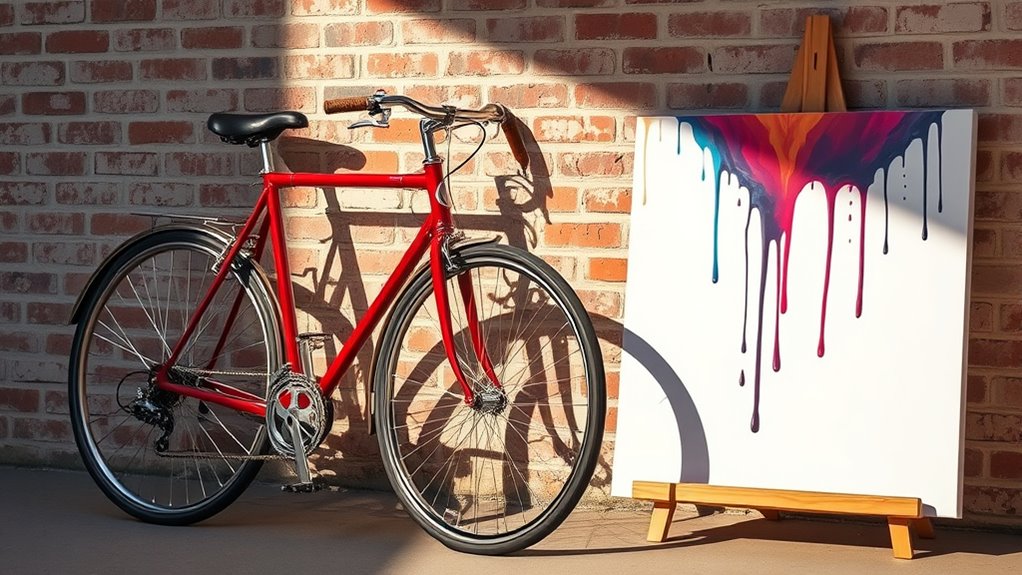
Photographers and painters find endless inspiration in the dynamic energy of pedal power, capturing the motion and emotion of cycling in their artworks. They focus on bike aesthetics, highlighting sleek lines, vibrant colors, and unique shapes that convey speed and grace.
Pedal inspired art often emphasizes the rhythm of cycling, using blurred backgrounds or motion trails to evoke movement. Artists may portray cyclists in landscapes, urban settings, or abstract compositions, celebrating the harmony between rider and machine. Incorporating visual storytelling allows artists to convey deeper narratives and emotional connections through their bike-inspired works. Additionally, understanding jet boat technology and design can inspire dynamic and fluid compositions that mirror the swift, powerful movement of watercraft, enriching their artistic expression.
Through photography, you can freeze fleeting moments of balance and effort, while paintings bring out the vibrancy and energy of pedal-powered motion. Exploring cycling biomechanics can deepen an artist’s appreciation for the physical dynamics involved, further enhancing their work. These artworks not only showcase the physical beauty of bikes but also express the passion and freedom that cycling inspires in you.
Cycling in Literature and Poetry
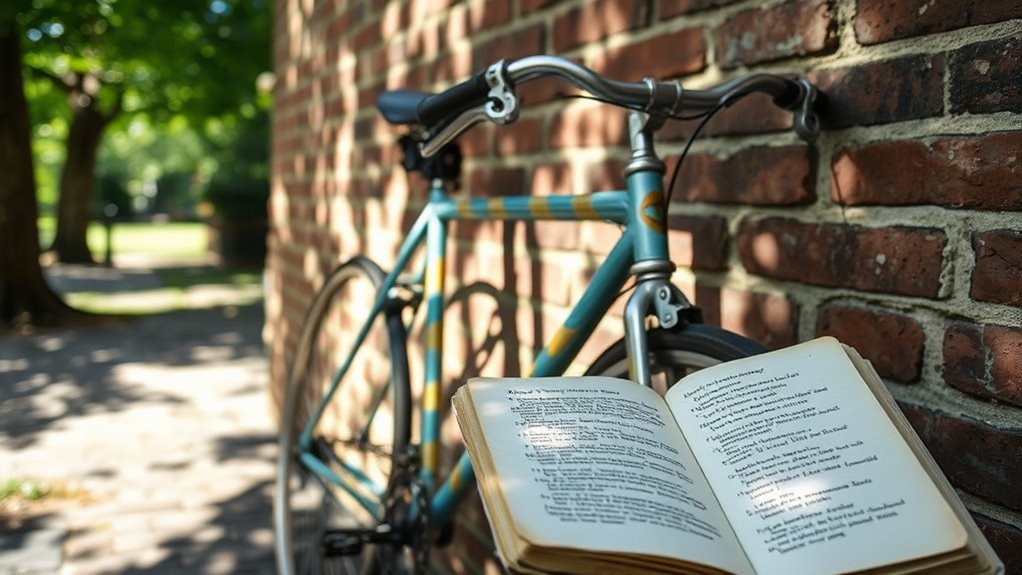
Have you ever noticed how cycling symbolizes freedom and adventure in literature and poetry? Writers often use bikes to evoke movement, independence, and exploration. Poems highlight the thrill of riding, the wind in your face, and the open road ahead. Literature also addresses bike mechanics, emphasizing skill and precision, while cycling safety underscores the importance of awareness and caution. Below is a table illustrating different themes associated with cycling in literature and poetry:
| Theme | Example | Symbolism |
|---|---|---|
| Freedom | “On the open road” | Escape from constraints |
| Adventure | Mountain biking stories | Exploration of the unknown |
| Skill & Mechanics | Descriptions of bike repairs | Mastery and craftsmanship |
| Safety | Riding helmets in poems | Caution and mindfulness |
| Nature & Movement | Cycling through forests | Connection with environment |
Additionally, the portrayal of bicycles in literature often emphasizes mechanical understanding and the importance of maintenance for safe riding experiences. Recognizing the significance of proper bike upkeep can enhance both safety and enjoyment during cycling adventures. Maintaining a bike with regular tuning and repairs ensures optimal performance and reduces the risk of accidents. Developing cycling techniques can also improve efficiency and confidence on various terrains. Proper bike care is essential for long-term durability and safe riding.
Frequently Asked Questions
How Do Different Bike Designs Influence Artistic Expression?
You see how different bike designs influence artistic expression by shaping how you perceive and create. Frame geometry affects the aesthetics and functionality, inspiring unique artistic styles.
Color palettes evoke emotions and set moods, fueling your creativity. When you explore various designs, you’re encouraged to experiment with form and hue, allowing your art to reflect the diverse influences of bike aesthetics.
Your creativity can thrive through these visual and structural inspirations.
What Are Emerging Trends in Bike-Inspired Digital Art?
You’ll notice emerging trends in bike-inspired digital art, like virtual galleries showcasing dynamic, interactive pieces.
Augmented reality plays a key role, allowing you to experience bike-themed art in real-world settings through your device.
Artists blend cycling motifs with innovative technology, creating immersive, engaging experiences that connect you with the movement and design of bikes.
These trends push the boundaries of creativity, inviting you to explore new dimensions of artistic expression.
How Do Cultural Perceptions of Cycling Vary Globally in Art?
You might think everyone sees cycling the same way, but cultural perceptions vary wildly in art. Ironically, in some places, bikes symbolize freedom and progress, while elsewhere, they’re linked to resistance or tradition.
These cultural symbols shape artistic narratives, reflecting each society’s values and history. So, as you explore global art, you’ll notice how cultural symbolism influences the way cycling is depicted, revealing diverse stories behind each frame.
Can Cycling Art Influence Urban Planning and Design?
You can see that cycling art influences urban planning and design by highlighting bike aesthetics and promoting urban mobility.
When you incorporate bike-inspired art into city spaces, it encourages the development of bike-friendly infrastructure, making cycling safer and more appealing.
This artistic approach inspires planners to prioritize sustainable transportation, fostering vibrant, accessible cities where cycling becomes a seamless part of everyday life.
How Do Artists Incorporate Sustainable Themes Through Bike Art?
Imagine a bike frame transformed into a sculpture, its recycled aesthetics catching your eye. Artists incorporate sustainable themes by creating eco-conscious sculptures from discarded parts, highlighting recycling aesthetics.
You might see bike wheels repurposed into flower arrangements or handlebars into wind chimes, emphasizing eco awareness. This coincidence of art and environmental care encourages viewers to rethink waste, inspiring sustainable practices through creative expression rooted in bicycle culture and ecological responsibility.
Conclusion
As you explore the vibrant world where bikes fuel creativity, you realize they’re more than just transportation—they’re a canvas for expression. Like a muse on wheels, bikes inspire artists to turn motion into masterpiece. Whether through murals, sculptures, or poetry, cycling sparks your imagination and invites you to see the world in new, colorful ways. So, next time you hop on your bike, remember: you’re riding a bridge between movement and art.
